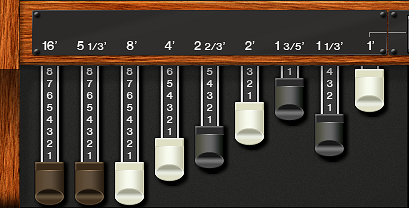Synth Basics: Organ Basics – ORGAN FOOTAGES – reface YC
We’ll start our discussion with the very first musical keyboard: the organ. With the release of the reface keyboards a timely discussion of real time sound design seems appropriate. The title as “father of the synthesizer” is real and fitting, because sound design on the organ front panel interface is like a course in the math and science behind the synthesizer. The organ is not only one of the first keyboards (period) it is unique in how the sound can morph into various shapes during the performance. While the pianoforte (also known as the “piano” to close friends), as a more recent invention, borrowed heavily on the key layout, but it did not have the same types of controls or ability to change timbre so radically at the whim of the performer. The organ is all about real time access and real time control over the tone of the instrument. The piano introduced something we know today as VELOCITY SENSITIVITY… which relates to the more energy exerted to depress a key the louder the sound output. This is used by pianist to evoke emotion from a composition. The organ was not velocity sensitive, it made no difference how much effort you used to press a key, the output is determined by the position of the Drawbars (Stops) and the SWELL pedal. So emotion is introduced by manipulating the relationships between the Drawbars settings and the right foot on the SWELL pedal. Therefore, before we dig into each of the reface instruments, we should use the organ, as an instrument, to introduce some of the basics – and these are all things you would learn studying music.

Let’s explore the basic musical mathematics behind the Drawbars. I’ve promised to use just enough math in these Synth Basics article so not to cause discomfort for the math challenged. And I intend to keep to that as much as possible. In doing so I hope to show that programming can be approached totally intuitively and some of this basic mathematical stuff can form a good background that can only help you – particularly from the standpoint of knowing where to look when attempting to sound design.
 The first drawbar, (Sub-octave) 16′
The first drawbar, (Sub-octave) 16′
The second drawbar 5 1/3 (the Quint)
The third drawbar (Principal) 8′
The fourth drawbar 4′ (the Octave)
The fifth drawbar 2 2/3 (1 Octave + a fifth above the Principal)
The sixth drawbar 2′ (2 Octaves above the Principal)
The seventh drawbar 1 3/5 (2 Octaves + a major third above the Principal)
The eighth drawbar 1 1/3 (2 Octaves + a fifth above the Principal)
The ninth drawbar 1′ (3 Octaves above principal)
The different drawbar names denote the “footage”… 16′ translates to a 16 foot pipe. 8′ translates to an 8 foot pipe, and so on. We’ll get more into this in the next installment. For now, recognize the bigger the pipe, the lower the note that is possible, and the shorter the footage, the higher the pitch of the sound produced. This is basic musical mathematics – if you play piano it is no surprise that the longer the string the lower the pitch and the shorter strings produce higher pitches.
Why is the second drawbar seemingly out of order? See, that’s why some people don’t like to look at the math behind music, it’s full of mysteries. And that is precisely why some people love this stuff! I contend that whether you know the math or not, observers from the far distant future will look back and find our music and conclude that it was the musicians who were the mathematical geniuses of our time. There is so much interplay between the numbers, divisions, subdivisions, multiples, harmonics and even inharmonic relationships in the sounds we use and combine so freely when we play. They will conclude that we were calculating outrageous formulas and doing mathematical multiplications and divisions at breakneck speeds… As if we intuitively understood the mathematical relationships and could do the calculations on the fly.
So like it or not, in the future you will be considered a mathematical genius in how you’ve mastered the relations between the numbers represented in the notes and in the sounds you’ve chosen to play! And while Drawbars are often thought about like the ‘Stops’ on a pipe organ, they are really not quite as sophisticated. The ‘stops’ on a pipe organ can often open an entire bank of pipes – while Drawbars each represent a single “harmonic”. In our next installment we will define some useful terms and begin our exploration of sound design on the “father of the synthesizer!”
Next Article: The Father of the Synthesizer II

 The first drawbar, (Sub-octave) 16′
The first drawbar, (Sub-octave) 16′